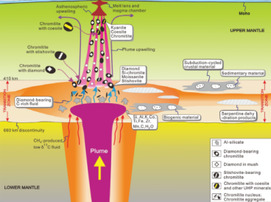Diamonds in Ophiolites
Ophiolites are a newly documented host of diamonds on Earth. Abundant diamonds have indeed been separated from peridotites and chromitites of ophiolites in China, Myanmar, and Russia. In addition, diamond grains have recently been discovered in chromite from the Cretaceous Luobusa ophiolite (Tibet) and the early Paleozoic Ray-Iz ophiolite (polar Urals, Russia). These diamonds are accompanied by a wide range of highly reduced minerals, such as Ni–Mn–Co alloys, Fe–Si and Fe–C phases, and moissanite (SiC); these have been found as either mineral separates or inclusions in diamonds and indicate growth under superreducing conditions. The diamond-bearing chromite grains likely formed near the mantle transition zone and were then brought to shallow levels in the upper mantle to form podiform chromitites in oceanic lithosphere. Because these diamond grains occur widely in peridotites and chromitites of many ophiolites, we refer to them as ophiolite-hosted diamonds. It is possible that such diamonds may be common in the upper oceanic mantle.
Diamonds in Ophiolites Read More »



